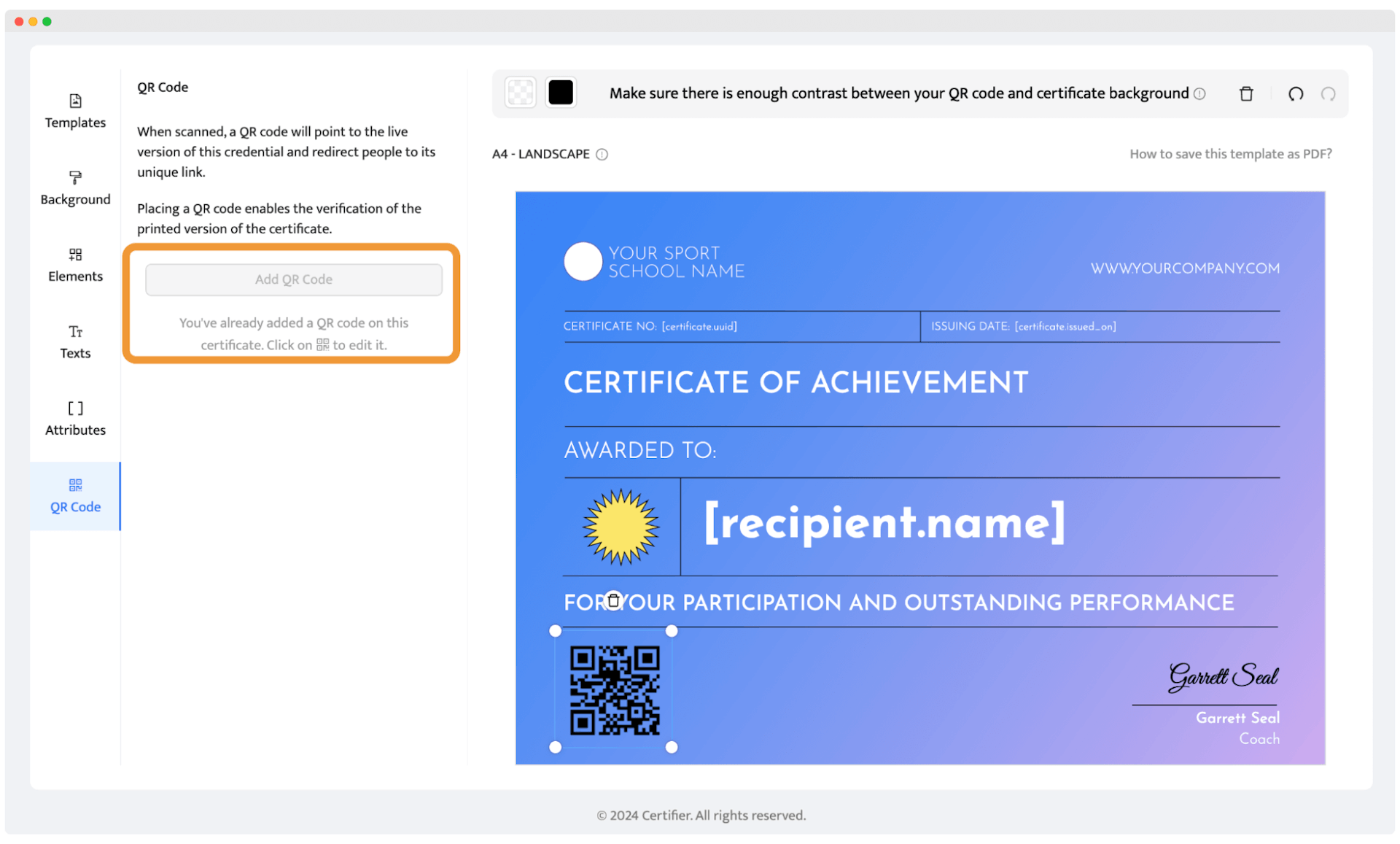Trusted by:
How to Verify a Degree: a Definite Guide
Do you know the easy way to check if a degree is real? Our guide helps schools issue degrees and certificates that are true, authentic, and, foremost, verifiable.
AuthorOla Kozielska
Updated: April 11, 2024
7 min read

Author
Ola Kozielska
Updated: April 11, 2024
7 min read
Trusted by:
Have you ever watched Catch Me If You Can with Leonardo Dicaprio? If yes, you probably know what a person with fake documents and a bit of cunning can do – make other people believe that they’re not who they claim to be. The consequences can be serious for both: a fraud and an organization.
Good, it’s just a movie (based on a true story, but quite far-fetched), and now the certificates and other educational credentials can be verified in just a snap.
Even more – you can create ones that are trustworthy and cannot be falsified. And that’s a huge value for any educational institution and its attendees.
We will show you how to do it! Scroll down.
Fraudulent documents – stats and facts
Falsified documents cause legal issues, which is a serious problem. To show you the problem’s scale, let’s take a look at the numbers and facts:
A 79% increase in document fraud was reported by financial services companies in 2022.
There's a lot of fraud happening with well-known institutions' documents.
By 2020, financial institutions based in the United States lost $20 billion due to synthetic identity fraud.
Less than 10% of document frauds are visible to the naked eye.
12% of fraudulent documents only have the identity details altered, which is a sign of third-party fraud.
Financial documents, tax forms, and business filings are among the most frequently manipulated ones.
Why verify the degrees?
Besides the obvious reasons, like being sure people really have the skills they say they do, there are some other aspects it’s better to be aware of:
It stops people from using fake degrees to get jobs or enter programs
Some people try to use fraudulent degrees, which are not real, to trick employers or schools.
Then, legitimate institutions and genuine companies can lose thousands of dollars if they trust an unqualified person with a fake degree. And here, it’s better if an attendee has a digital certificate because it’s easier and faster to verify the document.
No need to waste time calling the places a person attended and checking the students’ records.
For example: Verifying student records, although helps affirm the degree legalization, may take a few working days. And in some cases, it’s a necessary step – it ensures the certificate is not only a piece of paper but a testament of genuine, hard-earned academic achievement.
It helps employers pick the right person for the job
When a job needs someone with certain skills, the employer looks at their academic degree and other achievements. Nowadays, many people get their degrees online, so make sure the degrees are legal and real.
In job applications, degrees with verification from reputed universities add value and reassure employers of the candidate's sufficient work experience and academic records. Then, employers can be more confident in their choice – they know the person they hire has really learned what they require for the job.
It keeps the value of real degrees high
It’s hard to get a university degree – a bachelor's degree, master’s, PhD, whatever it is, people work hard in degree programs to earn them.
But if fake degrees start to appear, it makes the real ones seem less important. If anyone can just buy a fake degree, then the hard work people do in real degree programs seems less special because so many people have them.
So, not fair at all, isn’t it?
For example: Faculties in universities may uphold the integrity of degrees – they guarantee the legitimacy of academic records and support degree legalization.
But there’s a way to make legal degrees more secure – issue digital, easily verifiable ones.
How to verify a degree?
Gold stamping is not enough. So, how to check if a degree is legit? A scam detector or an external verification service might come in handy. But not everyone has or can afford them.
However, to make digital college degrees and other diplomas legitimate, there are some elements proving their legitimacy, and they can be verified quickly without any complicated processes.
And here’s what to do:
put a QR code on every certificate
give each degree a unique ID
list all the degrees on the school's website
add a digital signature to each certificate
provide a verification link for each degree that can be shared
Some may say easy to say, hard to do. But we’ve come to you with a solution.
Certifier is a certificate program that lets institutions and individuals create professional certifications and is also equipped with verification features.
Not sure how to do it? Here it is - a step-by-step guide to make your diploma certificate secure and verifiable:
Step 1: Create a Certifier account
Both individuals and educational institutions can sign up for Certifier in just a few clicks. All you need to do is enter the necessary information and decide on the plan. You can stay with the free one, but there’s no option to add a QR code at the lowest plan. If you want to make your diplomas verifiable, paid packages are advisable.
Sign up for Certifier or log in if you already have an account.
Step 2: Choose the template and customize it
Go through the templates and choose the one that catches your eye and suits the institution. You can add a logo, change colors fonts, and add or remove elements. All customizable.
Step 3: Add UUID as a dynamic attribute to make each certificate unique
Speaking of elements, make sure you make UUID a dynamic attribute. It’s a diploma ID, that makes verifying easier and more secure.

Step 4: Add a QR code through the QR code tab
When UUID is in place, it’s time for the QR code. Enter the QR code tab and generate the code. It’s super easy – you don’t have to use a third-party tool to create one. If you use a free plan, you need to upgrade to get the code.
Your QR code doesn’t have to be boring, you can customize it. Change the color and make it look as you like the most.

Read more about how to create a QR code for a diploma/certificate.
Step 4: Save and send out
Whenever it’s ready, save the template (you can save it as a draft and edit it later as well), upload the list of graduates, and send the documents out. They are sharable so that the recipients can add the diplomas to their LinkedIn or wherever they want.
Certifier’s features for validating certificates
Both diploma creators and recipients can check the authenticity and validity of the documents with these features:
#1 API
Open API makes it possible to quickly check if, for example, a bachelor degree is real. This stops fake degrees and life experience degrees that use legal loopholes.
Issued credentials can be checked using a unique link that a person just clicks it in order to check its validity – straightforward and fast.
#2 Issuer KYC procedure
The Know Your Customer (KYC) procedure confirms the identity of the issuer and adds a layer of trust and legitimacy to the certifications. It provides an honest belief in the digital credential's authenticity.
It’s super important in distinguishing legal degrees from fraudulent ones.
#3 Monitoring verification analytics
Issuers can track how many times their credentials have been verified. With this analytics feature, institutions can get insight into the recognition and acceptance of their credentials in the academic world.
#4 Verifying credential issuers
With a single click, the issuer’s status and the credential's validity can be checked at Certifier. Recipients and third parties can easily confirm the legitimacy of the issuing institution.
#5 All credential data centralized
Who gave the degree, who got it, when it was given, and a unique ID for each degree – all the info about the degree certificates is gathered in one place. Then, managing the documents is much easier. Precious time and effort saved!
#6 UUID-based verification
UUID (Universal Unique Identifier) is a unique ID for the document. UUID has a number that is unique across different systems. No two UUIDs are the same, even if they are generated by different systems at different times.
Now, when duplicating, for example, online degrees, is not that hard, the feature protects from spreading replica degrees.
All the features above make Certifier an excellent diploma company for educational institutions that seek to keep the authenticity of their degrees through, for example, government authority approval and international transactions.
Methods used by fraudsters
There are many ways degrees and other documents can be falsified:
DIY
Fraudsters use programs (such as Microsoft Office, Google Docs, Adobe Photoshop, and others) to create different documents: PhD degrees, doctoral degrees, documents from popular educational institutions, like Diploma Mills degrees, and more.
Some fake documents may be spotted right away, while others are more polished and non-detective.
Templates
They create templates that are similar to the original document. Fraudsters change personal details like name, surname, course, etc. Degrees look legit at first glance, but they might be easily spotted as falsified by the verification service as there are no document IDs and other verification components.
Mirage
With this method, fraudsters use software to create authentic payslips, related to unauthentic accounts. Mind that there are fake degree websites, and they can use that as well.
Also, if you, as an academic institution, have any doubts about some documents or identities (e.g., appreciation letter, graduation letter, degree application, acceptance letter, reference letter, internship letter, doctorate degree, etc.) fraudulently gained, don’t hesitate to consult legal advisors or fake degree verification service.
Bonus: Free verifiable degree diploma templates to download
Educational institutions that offer the option of earning a degree online may take advantage of the verifiable diplomas. Schools don’t have to hire a designer or create documents themselves.
Certifier’s templates gallery has plenty of diploma templates that are: customizable, sent in bulk, and, last but not least, verifiable.
So, no matter what online degrees the students earn, a school will always have editable templates to choose from.
Check the examples:
#1 Light brown

You can add an email address for easy contact. Certifier’s online verification feature adds credibility and allows for quick and secure confirmation of the certificate's authenticity.
#2 Formal bright

Universal, elegant, and ideal for any education level degree. You can put there a degree title or course name with just a few clicks.
#3 Elegant green

Don’t forget about the dynamic attributes – they let you send documents in bulk to dozens, hundreds, or even thousands of attendees, and keep the integrity and traceability of academic records.
Conclusion
Certifier's features for validating certificates bring a lot of value to the people who give out degrees. They can ensure they issue legit, verifiable degree documents, all aligned with the law.

Ola Kozielska
Content designer. At Certifier, Ola crafts user-friendly content that makes complex information easy to grasp.
Ola Kozielska
Content designer. At Certifier, Ola crafts user-friendly content that makes complex information easy to grasp.
Share this article